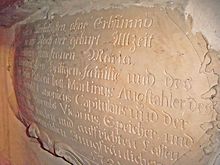Martin Augsthaler
Martin Augsthaler , also Martin Augstahler (* before 1711, † around 1749) was a German collegiate capital in Oberwesel and canon in the diocese of Worms and the archbishopric of Trier .
Life

Martin Augsthaler did not have a title of nobility and probably came from middle-class circles. Due to various foundations in favor of the church, he appears to have been quite wealthy. The name of his parents, Leonhard and Catharina Augsthaler, comes from the church book entry for his sister's marriage in 1711 in Worms Cathedral .
As early as 1712 he appeared in Pfeddersheim as master storage of the Worms Cathedral monastery . In this capacity, he ensured that the incoming goods in kind (grain, crops, etc.) were properly kept and stored.
In 1725 Augsthaler laid the foundation stone for the new Lutheran St. Peter's Church in Sausenheim , which, at the request of the Counts of Leiningen as local rulers, had to continue to be financially supported by its Catholic patron saint, the Worms Cathedral Chapter. In 1740 he also had the associated tithe barn renovated here.
As Trier cathedral vicar , Martin Augsthaler was presented in 1727 by the responsible patron saint, Count Karl Kaspar von der Leyen (1655–1739), to canon and capitular at the Liebfrauenstift Oberwesel . In Oberwesel there is a former Hofgut von Augsthaler with a Baroque archway marked in 1719 that bears his building inscription. It is the only known residence of an Oberwesel canon outside of the monastery immunity. According to the year of construction in 1719, he seems to have already owned it before he became canon there in 1727; it is unclear whether he lived there as a collegiate capital.
In 1728 the clergyman had a baroque high altar made of yellow sandstone built in the Catholic Church of St. Stephan zu Sausenheim . As a special feature, it has a breakthrough with a glass painting of the church patron St. Stephan , which is illuminated from a window behind it. Sausenheim belonged to the diocese of Worms until 1801 and the church's patronage rights belonged to the Worms cathedral chapter . According to the donor's inscription (1728) on the back of the altar, Augsthaler was at that time abbey capital in Oberwesel, cathedral vicar in Worms and storeroom and cellar master of the Worms cathedral monastery . In addition to the dedication to the church patron Stephanus, the cathedral vicar noted in the text that he also erected the altar "in honor of the most blessed, received without original sin, before and after the birth of the always immaculate virgin Mary, mother of the most high " . Accordingly, he seems to have been an outspoken admirer of Mary and, interestingly, testifies here in advance to the doctrine of the Immaculate Conception as early as 1728 , which was only dogmatized bindingly in 1854 . The sculptor Balthasar Barban from Hettenleidelheim , a brother-in-law of Martin Augsthaler, is named as the creator of the altar . He had married the priest's sister on February 16, 1711, in Worms Cathedral.
In 1738 Augsthaler donated a larger high altar of a similar design - possibly also made by his relative - for the Worms Cathedral , where it is located on the east wall of the north transept. It is consecrated to St. Walburga and bears a dedication inscription (1738) by the cleric on the front on the predella . This shows him for 1738 as cathedral vicar of Worms, abbey capital in Oberwesel as well as storeroom and cellar master of the Worms cathedral monastery. In addition, it says here that he is the sub- senior (probably the second oldest) of the Worms cathedral vicars.
Martin Augsthaler died around 1749. In that year the Minorite Monastery of Oberwesel (preserved as a ruin) received 1500 guilders from him in his will to build up the Latin school there.
literature
- Johann Samuel Publication : General Encyclopedia of Sciences and Arts , 3rd section, 1st part, p. 153, Leipzig, 1830; (Digital scan)
- State Office for the Preservation of Monuments: The Art Monuments of Bavaria , Administrative Region Palatinate, VIII. City and District Frankenthal, Oldenbourg Verlag, Munich, 1939, pages 466–467
- Klaus Schmitt: The Catholic Church St. Stephanus Sausenheim , Sommer Verlag, Grünstadt, 1999, p. 44 u. 45
Web links
Individual evidence
- ↑ Stadtarchiv Worms: 1250 Years Pfeddersheim , Worms, 2004, p. 30; (Detail scan)
- ↑ Klaus Schmitt: The Catholic Church of St. Stephanus Sausenheim , Sommer Verlag, Grünstadt, 1999, p. 21
- ↑ Ferdinand Pauly : Germania Sacra New Series , Volume 14: The Dioceses of the Church Province of Trier. The Archdiocese of Trier (Volume 2), the stifts of St. Severus in Boppard, St. Goar in St. Goar, Liebfrauen in Oberwesel, St. Martin in Oberwesel , Verlag Walter de Gruyter, 1980, p. 396; (Detail scan)
- ^ The Liebfrauenstift Oberwesel in the monastic dictionary of Rhineland-Palatinate
- ↑ Klaus Schmitt: The Catholic Church of St. Stephanus Sausenheim , Sommer Verlag, Grünstadt, 1999, p. 45
- ^ Genealogical page on the married couple
- ^ Ernst Wörner: Art monuments in the Grand Duchy of Hesse: inventory and descriptive representation of the works of architecture, sculpture, painting and the arts and crafts up to the end of the 18th century. Century: Province of Rheinhessen: Worms district , Darmstadt, 1887, p. 189; (Digital view)
- ^ Website of the Minorite Monastery in Oberwesel
| personal data | |
|---|---|
| SURNAME | Augsthaler, Martin |
| ALTERNATIVE NAMES | Augstahler, Martin |
| BRIEF DESCRIPTION | German cleric and canon |
| DATE OF BIRTH | before 1711 |
| DATE OF DEATH | around 1749 |



